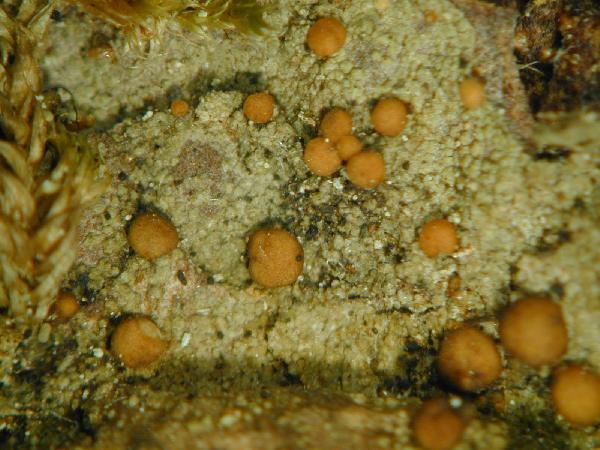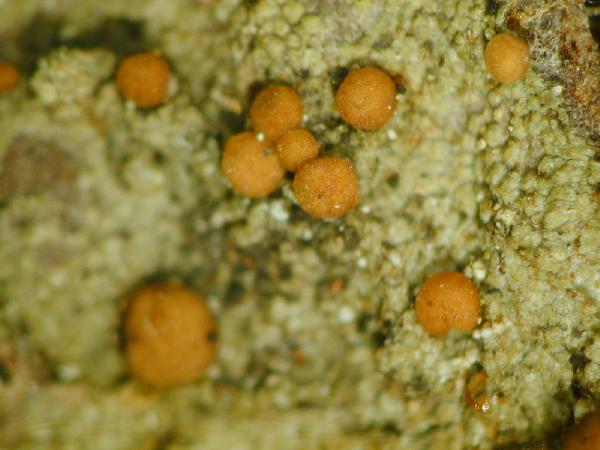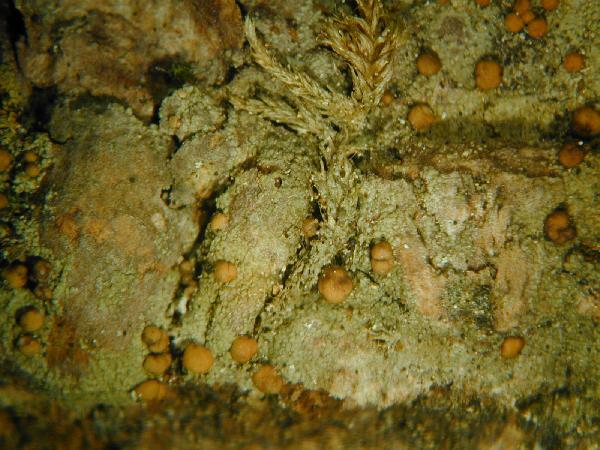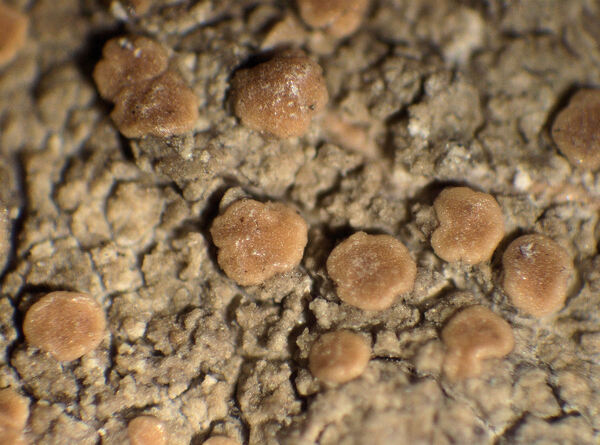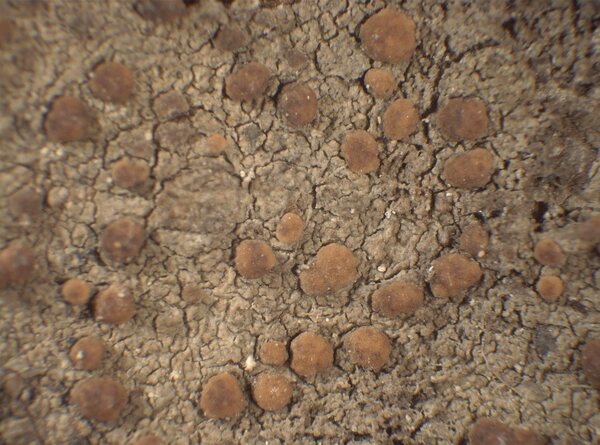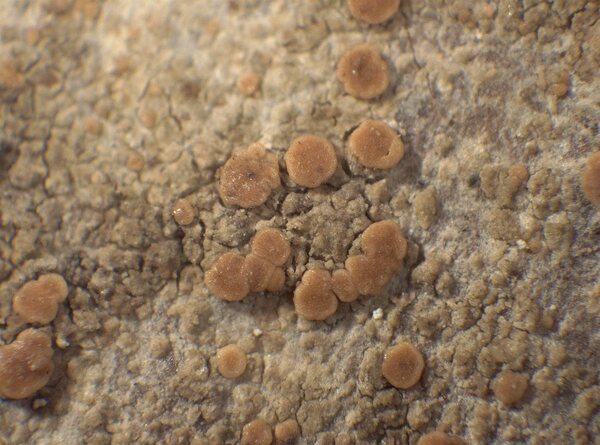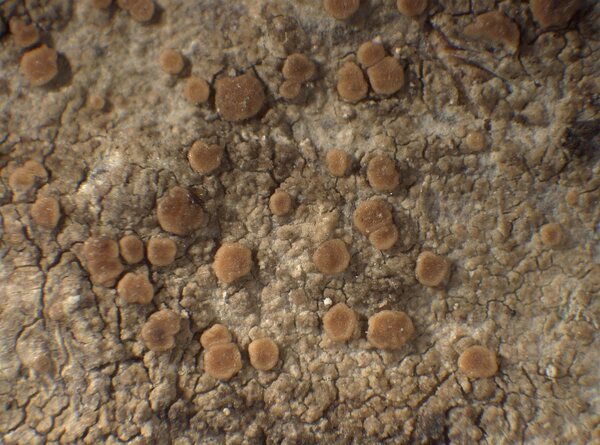Biatora helvola Hellb.
Körb. ex Hellb., Öfvers. K. Svensk. Vetensk.-Akad. Förh., 24: 271, 1867.
Synonyms: Lecidea vernalis subsp. helvola (Hellb.) Th. Fr.
Description: Thallus crustose, episubstratic, greenish grey to pale grey, continuous, rimose or warted, the warts weakly convex and irregular in outline, 0.1-0.3 mm wide. Apothecia biatorine, rounded or slightly irregular in outline, sessile with a slightly constricted basis, single and 0.3-0.5 mm across, or coalescing-tuberculate and 0.5-1 mm across, with a beige to pale reddish brown, epruinose, flat to moderately convex disc, and a concolorous or paler, thin, soon excluded proper margin. Proper exciple colourless or yellowish, of radially arranged hyphae, laterally 30-70 µm wide, basally much wider, the outer part often with tiny granules of gyrophoric acid forming a smear between the hyphae; epithecium scarcely differentiated from the hymenium, colourless or pale yellow; hymenium 40-60 µm high, colourless or yellowish, the pigmented parts often arranged in thin longitudinal stripes; paraphyses simple or sparingly branched in upper part, 1-1.5(-2) µm thick at mid-level, the apical cells to 2.5-3 µm wide; hypothecium colourless or pale yellow, 25-110 µm high. Asci 8-spored, clavate, with a K/I+ blue apical dome penetrated by a narrow, K/I- apical cushion surrounded by a narrow, deeply K/I+ blue zone, the wall K/I- but surrounded by an I+ red-brown, K/I+ blue outer layer, the ocular chamber relatively small, Biatora-type, 31-46 x 7-12 µm. Ascospores 1-celled (rarely 1-septate), hyaline, (8.5-)10-14(-17) x 3-5 µm. with a c. 0.5 mm thick perispore. Pycnidia rare, immersed, to 40 µm across, the wall colourless. Conidia bacilliform, 6.5-8 x 0.7-1 µm. Photobiont chlorococcoid. Spot tests: thallus K-, C- or faintly C+ pink, KC- or faintly KC+ pink, P- (positive reactions often fleeting and poorly evident); apothecial sections fleeting C+ pink. Chemistry: gyrophoric acid (major), and traces of lecanoric acid.
Growth form: Crustose
Substrata: bark
Photobiont: green algae other than Trentepohlia
Reproductive strategy: mainly sexual
Commonnes-rarity: (info)
Alpine belt: absent
Subalpine belt: rather common
Montane belt: rather rare
Dry submediterranean belt: absent
Humid submediterranean belt: absent
Padanian area: absent
pH of the substrata:
1 2 3 4 5
Solar irradiation:
1 2 3 4 5
Aridity:
1 2 3 4 5
Eutrophication:
1 2 3 4 5
Poleotolerance:
0 1 2 3
Altitudinal distribution:
1 2 3 4 5 6
Rarity
absent
extremely rare
very rare
rare
rather rare
rather common
common
very common
extremely common
Loading data...
Occurrence data
Predictive map
Growth form: Crustose
Substrata: bark
Photobiont: green algae other than Trentepohlia
Reproductive strategy: mainly sexual
Commonnes-rarity: (info)
Alpine belt: absent
Subalpine belt: rather common
Montane belt: rather rare
Dry submediterranean belt: absent
Humid submediterranean belt: absent
Padanian area: absent
pH of the substrata:
| 1 | 2 | 3 | 4 | 5 |
Solar irradiation:
| 1 | 2 | 3 | 4 | 5 |
Aridity:
| 1 | 2 | 3 | 4 | 5 |
Eutrophication:
| 1 | 2 | 3 | 4 | 5 |
Poleotolerance:
| 0 | 1 | 2 | 3 |
Altitudinal distribution:
| 1 | 2 | 3 | 4 | 5 | 6 |
Rarity
absent
extremely rare
very rare
rare
rather rare
rather common
common
very common
extremely common
Loading data...
Occurrence data
Predictive map


